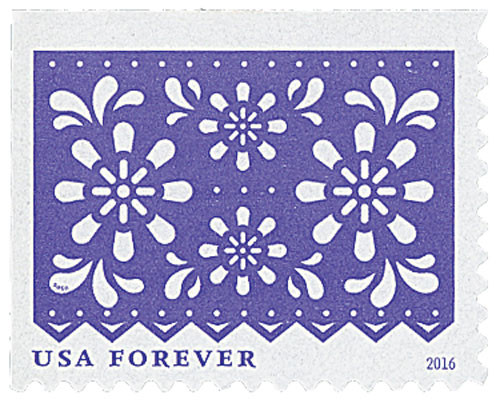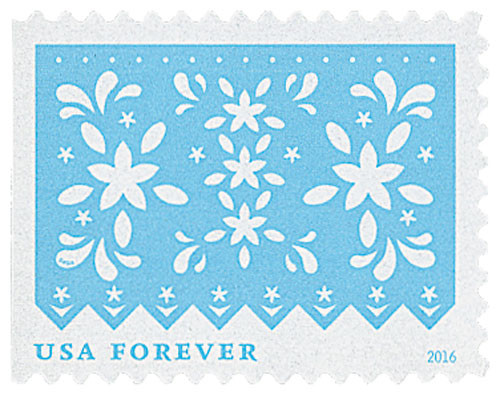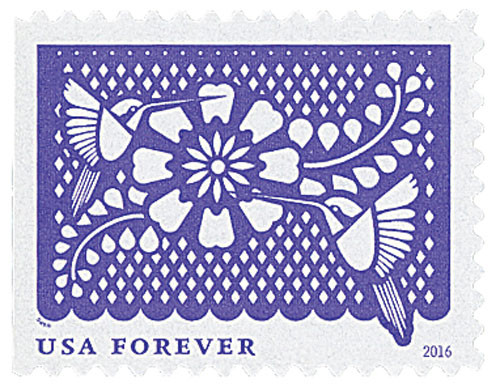
# 5081 - 2016 First-Class Forever Stamp - Colorful Celebrations: Light Blue Bird with White Flowers
US #5081
2016 Light Blue Bird & Flowers – Colorful Celebrations
- One of 10 designs meant to be used to send celebratory mail
Stamp Category: Commemorative
Set: Colorful Celebrations
Value: 47¢ First Class Mail Rate (Forever)
First Day of Issue: June 3, 2016
First Day City: New York, New York
Quantity Issued: 100,000,000
Printed by: Banknote Corporation of America
Printing Method: Offset, Microprint
Format: Double-sided Booklets of 20
Tagging: Phosphor tagged paper, block
Why the stamp was issued: Intended to celebrate all manner of festive occasions.
About the stamp designs: Features an image of a piece of light blue papel picado (Spanish for pierced paper) designed by Sally Andersen-Bruce. The stamp pictures geometric shapes, flowers, and a bird.
First Day City: The First Day of Issue Ceremony was held at the World Stamp Show in New York City.
About the Colorful Celebrations set: 10 stamps picturing Spanish papel picado (pierced paper) designs in different colors (light blue, orange, violet, or rose pink). Intended to celebrate a wide variety of occasions one might send mail for.
History the stamp represents: In less than 200 years, papel picado (perforated paper) has grown from an improvised craft of the working class to a revered art form and staple at many Mexican celebrations.
The Aztecs once created ceremonial art from rough paper called amatl. Later, in the 1800s, laborers living and working at haciendas (large estates) began making similar art. These laborers were craftsmen, farmhands, and other types of skilled workers, who made money for the estate owners through their trades. The laborers purchased their necessities from hacienda stores. These stores carried papel de China (Chinese paper), or tissue paper as it is known in America.
The hacienda workers purchased the inexpensive paper and began using chisels to cut stacks of it into elaborate designs to hang at celebrations. Over time, their crafts became so popular the hacienda stores wanted to buy them. Eventually, laborers became artisans, and their work was in high demand. Over the years, they passed their craft onto new generations to keep the art form alive.
Today, papel picado can be found at many Mexican celebrations, with more elaborate designs than ever. Though machine-produced designs have emerged, they cannot compare to the artistry of the skilled craftsmen who carry on the tradition of their ancestors.
US #5081
2016 Light Blue Bird & Flowers – Colorful Celebrations
- One of 10 designs meant to be used to send celebratory mail
Stamp Category: Commemorative
Set: Colorful Celebrations
Value: 47¢ First Class Mail Rate (Forever)
First Day of Issue: June 3, 2016
First Day City: New York, New York
Quantity Issued: 100,000,000
Printed by: Banknote Corporation of America
Printing Method: Offset, Microprint
Format: Double-sided Booklets of 20
Tagging: Phosphor tagged paper, block
Why the stamp was issued: Intended to celebrate all manner of festive occasions.
About the stamp designs: Features an image of a piece of light blue papel picado (Spanish for pierced paper) designed by Sally Andersen-Bruce. The stamp pictures geometric shapes, flowers, and a bird.
First Day City: The First Day of Issue Ceremony was held at the World Stamp Show in New York City.
About the Colorful Celebrations set: 10 stamps picturing Spanish papel picado (pierced paper) designs in different colors (light blue, orange, violet, or rose pink). Intended to celebrate a wide variety of occasions one might send mail for.
History the stamp represents: In less than 200 years, papel picado (perforated paper) has grown from an improvised craft of the working class to a revered art form and staple at many Mexican celebrations.
The Aztecs once created ceremonial art from rough paper called amatl. Later, in the 1800s, laborers living and working at haciendas (large estates) began making similar art. These laborers were craftsmen, farmhands, and other types of skilled workers, who made money for the estate owners through their trades. The laborers purchased their necessities from hacienda stores. These stores carried papel de China (Chinese paper), or tissue paper as it is known in America.
The hacienda workers purchased the inexpensive paper and began using chisels to cut stacks of it into elaborate designs to hang at celebrations. Over time, their crafts became so popular the hacienda stores wanted to buy them. Eventually, laborers became artisans, and their work was in high demand. Over the years, they passed their craft onto new generations to keep the art form alive.
Today, papel picado can be found at many Mexican celebrations, with more elaborate designs than ever. Though machine-produced designs have emerged, they cannot compare to the artistry of the skilled craftsmen who carry on the tradition of their ancestors.















